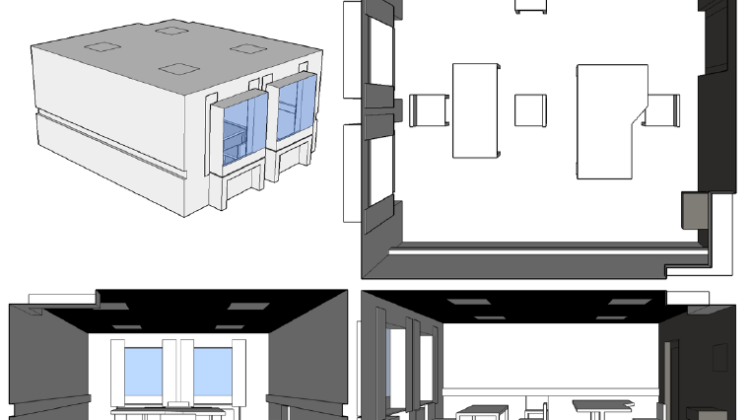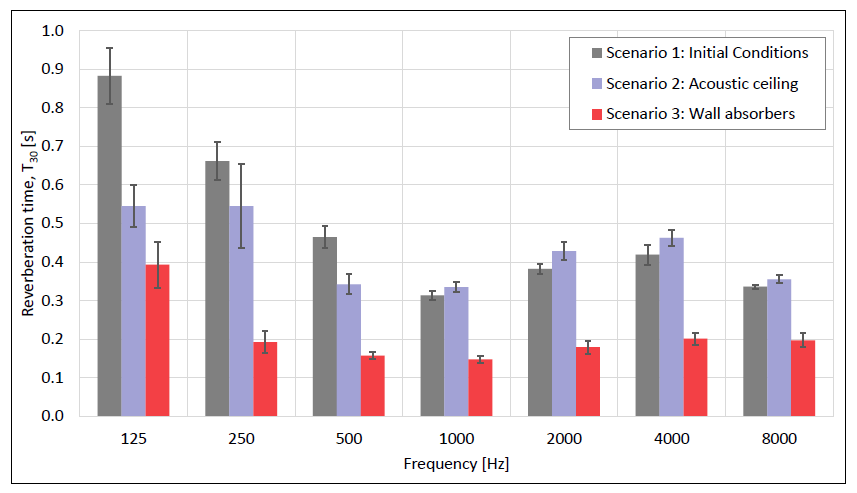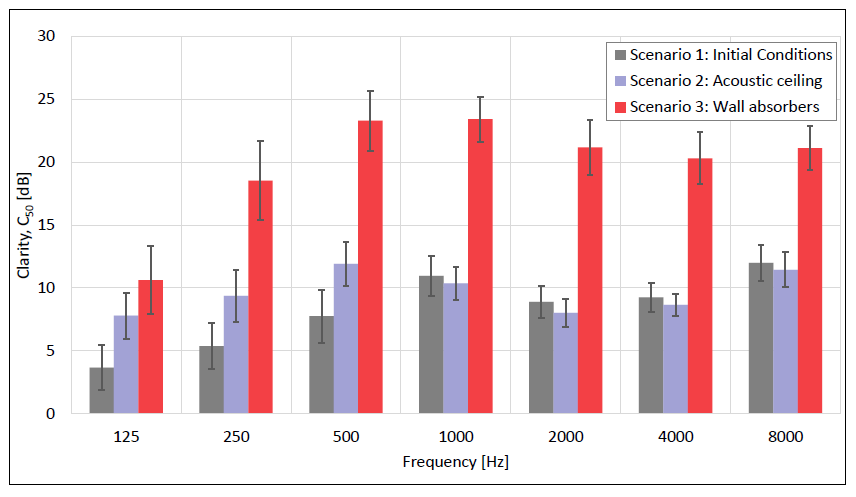
Intervention study in an audiology department
As part of the course ‘Architectural Acoustics’ at DTU – Technical University of Denmark, four students (Tobias Thydal, Vamsy Maddipati, Kat Herlo Benfelt Jensen and Christian Pedersen) chose to do an intervention study at the audiology department at Gentofte Hospital near Copenhagen in Denmark. The primary scope of the project was to get as close to free field conditions as possible:
Sound in a free field is unreflected, unabsorbed, undeflected, undiffracted, unrefracted, undiffused, and not subjected to resonance effects. … generally, a free field is a theoretical invention, a free space that allows sound to travel without interference*.
(*Alton Everest & Ken C. Pohlmann. Master Handbook of Acoustics. The McGraw-Hill Companies, 1993)
Free field conditions are impossible to obtain in a ‘normal’ room and the students therefore aimed to reduce the reverberation time of the room to 0.2 sec., achieve STI and D50 values above 0.9 – two descriptors that are very important in regards to audiometry tests where speech intelligibility is highly important.
Design of the study
The study was designed as follows:
- Acoustic measurements before acoustic intervention (‘the original room’) – ‘scenario 1’.
- Acoustic intervention – ceiling – ‘scenario 2’.
- Acoustic measurements
- Acoustic intervention – adding wall panels – ‘scenario 3’.
- Acoustic measurements
On top of this the students also did simulations in Odeon and calculations in the Ecophon Acoustic Calculator (EAC).

The original acoustic ceiling was an older perforated metal ceiling in a grid system (commonly used in Danish hospitals) with a 13 cm. air gap to the soffit.
There is no Danish standard or guideline for special rooms like this but according Principles of Hearing Aid Audiology (Maryanne Tate. Principles of Hearing Aid Audiology. Springer, 1994) the reverberation time in rooms designed for audiometry tests should be below 0.25 s. Unfortunately, the initial condition did not meet this at all – in fact the measurements showed that RT on 125 Hz was nearly 0.9 sec. and that 0.25 sec. was not met on any of the octave bands.
A new overall guideline for hospitals will be published during 2018 and in treatment rooms, examination rooms etc. the demand will be 0.6 sec. The initial condition did not meet this on the lower frequencies either.
The students did the ceiling intervention themselves – both demounting the old ceiling and installing the new one – and it was a big privilege to see how easy they managed to do this – without experience, without help. The ceiling installed was a 20 mm. class A glass wool absorber (in the existing grid system) and on top of that a 50 mm. bagged x-bass absorber (40% coverage).

Results
The results showed that just by changing the ceiling the room would now live up to the coming demands for hospitals since RT was below 0.6 sec. on all octave bands – but the measurements also showed that reaching 0.25 sec. of RT was not possible in this condition.
A professional carpenter later installed the wall absorbers – and the results after this speak for themselves:

When we look at the measurements for C50 it is interesting to see the development. According to this intervention study wall absorbers are highly important in rooms for audiometry testing.

As mentioned the students also measured D50 and STI and they succeeded in reaching >0.9:

Conclusion
The students conclude the following:
After the installation of the new ceiling absorption, clearly a reduction in the reverberation time can be noticed in the lower frequency bands showing the efficiency of the extra bass absorber from Ecophon. After adding the wall absorption, we are able to achieve the desired reverberation time and high clarity in all the frequency bands above the Schroeder frequency. The measured values for STI and definition also show high values indicating an excellent speech intelligibility.
The Odeon simulations were quite close to the measurements whereas the EAC calculations showed a similar pattern but was not as close as the Odeon results.
The end user of the room (Erik Kjærbøl, M.Sc. E.E., Department of Otorhinolaryngology, Head and Neck Surgery & Audiology, Audiological Department) states that the room is ‘really great!’ and that they look forward to start using it for audiometry tests for children. The room will be used for the first time during June 2018.

